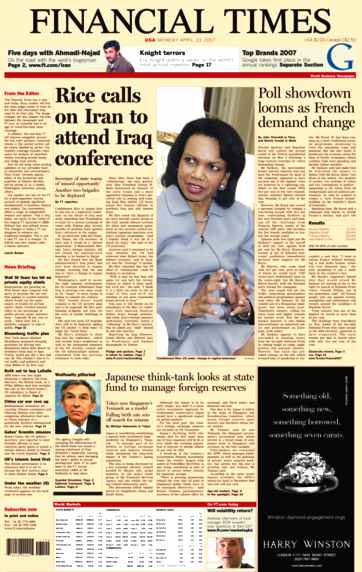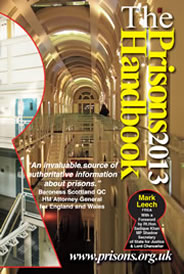|
FINANCIAL TIMES NEWS LINKS
|
|||
|
The Financial Times (FT) is a British international business newspaper. In the UK, it is a morning daily newspaper published in London that has had a strong influence on the financial policies of the British government. It is known as one of the UK's superior daily newspapers. The periodical is printed in 23 cities.
Founded in 1888 by James Sheridan and his brother, the Financial Times competed for many years with four other finance-oriented newspapers, finally in 1945 absorbing the last of these, the Financial News (founded in 1884). The FT has specialized in reporting business and financial news while maintaining an independent editorial outlook. On occasion it has attacked the financial policies of the British government. Circulation of the FT is said to be one of the world's highest among financial newspapers, second only to that of The Wall Street Journal. Printed as a broadsheet on distinctive light salmon pink paper, the FT is the only paper in the UK providing full daily reports on the London Stock Exchange and world markets.
History
The FT was launched as the London Financial Guide on January 9, 1888, by Horatio Bottomley, renaming itself the Financial Times on February 13 of the same year. Describing itself as the friend of "The Honest Financier and the Respectable Broker", it was initially published as a four page journal from its headquarters in London. The initial readership was the financial community of the City of London. The Financial Times soon established itself as the sober but reliable "stockbroker's Bible" or alternatively "parish magazine of the City", with its only rival being the slightly older and more daring Financial News. In 1893, the FT turned salmon pink — although later credited as a marketing masterstroke that made it immediately distinguishable from its competitor, the similarly named Financial News (founded 1884) this move was in truth inspired by economy - pink paper being cheaper than white. In 1993, the FT printed a single edition of the paper on white stock to commemorate this change a hundred years earlier. From their initial rivalry, the two papers merged in 1945 to form a single six-page newspaper. The Financial Times brought with it a higher circulation, while the Financial News provided enormous editorial talent.
Over the years, the newspaper grew in size, readership and breadth of coverage. It also established a network of correspondents in major cities around the world, reflecting early moves in the world economy towards globalisation.
As cross-border trade and capital flows increased rapidly during the 1970s, the FT began a programme of international expansion, facilitated by developments in technology and the growing acceptance of English as the international language of business.
On 1 January 1979, the first FT to be printed outside the UK rolled off the presses in Frankfurt. Since then, with its greatly increased international coverage, the FT has become a truly global business newspaper, printed in 23 locations worldwide, with three international editions to serve the needs of its readers in the UK, Continental Europe, the US and Asia.
The European edition is distributed in Continental Europe, Middle East, Africa and Asia. It is printed Monday to Saturday at five strategically located print centres across Europe. Thanks to its extensive network of correspondents reporting from all the political and commercial nerve centres of Europe, the FT is widely regarded to be the premier news source involving the European Union, the Euro, and European corporate affairs.
On 13 May 1995 the Financial Times group made its first foray into the online world with the launch of the first version of [FT.com] which was the result of internal development effort. This edition provided a high level summary of news stories from around the globe and was supplemented in February 1996 with the launch of stock prices followed in Spring 1996 by the second generation site. The site was advertising funded and contributed to the development of the emerging online advertising market in the UK in the late 1990s. Between 1997 and 2000 the site underwent several revamps and changes of strategy as both the FT Group and Pearson reacted to the rapidly changing online marketplace. FT.com is now one of the few UK news sites successfully operating a subscription model for content.
In 1997, the FT launched the US edition, which is now printed in New York, Chicago, Los Angeles, San Francisco, Dallas, Atlanta, Orlando and Washington, DC, although the newspaper was first printed in the United States outside of New York City in 1985. In March 2006, the FT's US circulation was 137,845.
In September 1998, the FT became the first UK-based newspaper to sell more copies internationally than within the UK. Worldwide circulation stands at 432,548 (Source: ABC July 2006), with global readership estimated at over 1.6 million people in more than 140 countries.
Since 2000, the FT publishes a German language edition, Financial Times Deutschland, with its own news coverage. Its circulation in 2003 was approximately 90,000.
The current editor of the FT is Lionel Barber, who took over from Andrew Gowers in the autumn of 2005, who reportedly left over strategic differences.
On April 23, 2007, following in the wake of other notable newspaper redesigns such as the January 2007 Wall Street Journal revamp, the FT also re-launched the paper, complete with a new typeface, new labeling, but with no reduction in paper size (unlike with the recent Wall Street Journal redesign or the expected New York Times redesign). This redesign has been billed by some as the “most dramatic revamp [of the FT] in a generation” and, in addition to the typeface changes, includes the addition of more panels in the news pages, more first page feature content in the “Companies and Markets” section, and more “squeezed” sports content, to allow for an extra foreign news page. FT editor Barber notes that the changes are “evolutionary and will provide extra news, deeper analysis and comment. By improving the navigation of the newspaper, we're aiming to help our busy readers get more out of the paper so that they understand that the Financial Times is not only as an informative and entertaining read, but also as an essential business tool” and he dubs the redesigned paper as being a “sharper” FT. Some subtle changes include the reintroduction, above the leaders, of the FT's original 1888 motto, “Without fear and without favour” and more signposts to FT.com. To coincide with the redesign, Pearson PLC announced a new advertising campaign centred around the tag-line “We Live in Financial Times”. The FT redesign was handled by and was the first major project for design firm Shakeup Media and young American designer Ryan Bowman.
The Financial Times office building in London
Content
The Financial Times reports extensively on business and features extensive share and financial product listings. It also has a sizeable network of international reporters – about 110 of its 475 journalists are based outside the UK. The FT is usually in two sections, the first section covers national and international news, while the second section covers company and markets news.
How to Spend It
How to Spend It magazine is a monthly magazine that is usually published with the Financial Times Weekend Edition. The glossy large magazine has won the hearts of many Weekend Edition subscribers, with its high detail on the latest in the glitz and glamour of the high-life. Its articles mostly concern high quality products: yachts, mansions, apartments, designs, horlogerie, haute couture, automobiles, fashion advice and columns by important individuals in the arts in gardening, food, the hotel business, and travel industries. It regularly themes its issues, such as "Travelling Unravelled", "A Passion for Fashion", "Superior Interiors", and its annual "Christmas Unwrapped". How to Spend It has won numerous prizes for being the best newspaper supplement of the year.
Opinions
The Financial Times is normally seen politically as centrist, although to the left of its principal competitor, The Wall Street Journal. It advocates free markets and is generally in favour of globalisation. During the 1980s it supported Margaret Thatcher and Ronald Reagan's monetarist policies. However, it has recently seemed to have aligned itself with Labour in the UK. It also has been quite supportive, until recently, of Gordon Brown, the current British Prime Minister. FT editorials have tended to be pro-European Union, though often taking a critical view. Several members of British far-left groups, however, do work for the paper, and it is popular among the left (Noam Chomsky cites it as a useful newspaper; he has said that it is "the only paper that tells the truth").
The Lex column
The Lex column is a regular feature which appears daily (and in the weekend edition) on the back page of the first section. The content Lex column features analysis and opinions on a range of business and financial topics and is global in scope. The FT calls Lex its agenda setting column. The column first appeared on Monday 1st October 1945. The origin of the name of the column remains uncertain. It was conceived by Hargreaves Parkinson who originally conceived it for the Financial News in the 1930s and took it to the Financial Times when the two papers merged.
Ownership and related products
FT Knowledge is an associated company, through Pearson PLC, which offers educational products and services to a variety of customers. FT Knowledge has offered the "Introducing the City" course (which is a series of Wednesday night lectures/seminars, as well as weekend events) during the Autumn and Spring since 2000.
FT Predict is a prediction market contest the Financial Times is hosting that allows users to buy and sell contracts based on future financial, political, and news-driven events by spending fictional Financial Times Dollars (FT$). Based on the assumptions displayed in James Surowiecki's The Wisdom of Crowds, this contest allows people to use prediction markets to observe future occurrences while competing for weekly and monthly prizes.
Financial Times Group includes the Financial Times, FT.com, a 50% shareholding in The Economist, Interactive Data Corporation (a market data provider) , ownership of Les Échos (a Paris-based financial daily), Mergermarket (an online intelligence reporting family) and numerous joint ventures including Vedomosti in Russia. In addition, the FT Group has a unit called FT Business which is a provider of specialist information on retail, personal and institutional finance segments. It is a publisher in the UK of Investors Chronicle (a personal finance magazine), The Banker, Money Management and Financial Adviser (a publication targeted at professional advisers).
The Financial Times also ran a business related game called "In the Pink" (a reference to the colour of the newspaper, and to the phrase "in the red" meaning to be making a loss). The player is put in the virtual role of Chief Executive and the goal is to have the highest profit when the game closes. The winner of the game (the player who makes the highest profit) will receive a real monetary prize of £10,000. The game ran from 1 May to 28 June 2006.
People
In July 2006, the FT announced a "New Newsroom" project to integrate the newspaper more closely with FT.com. At the same time it announced plans to cut the editorial staff from 525 to 475. In August, it announced that all the required job cuts had been achieved through voluntary layoffs.
A number of former FT journalists have gone on to high-profile jobs in journalism, politics and business. Robert Thomson, previously the paper's US managing editor, is now editor of The Times. Will Lewis, a former New York correspondent and News Editor for the FT, is the current editor of the Daily Telegraph. Dominic Lawson went on to become editor of the Sunday Telegraph until he was sacked in 2005. Andrew Adonis, a former education correspondent, became an adviser on education to Tony Blair, the British prime minister, and was given a job as an education minister and a seat in the House of Lords after the 2005 election. Ed Balls became chief economic adviser to the Treasury, working closely with Gordon Brown, the chancellor of the exchequer (or finance minister) before being elected as an MP in 2005, and has been Secretary of State for Children, Schools and Families since July 2007. Bernard Gray, a former defence correspondent and Lex columnist, was chief executive of publishing company CMP before becoming chief executive of TSL Education, publisher of the Times Educational Supplement.
References
News A to Z directory, please click on the links below to find your favourite news or to contact the media to tell your story:
WE ACCEPT NO RESPONSIBILITY FOR THE ACCURACY OF ANY FEATURED LINKS
| |||
|
IF YOU HAVE ANY GOOD STORIES TO TELL WE'D LIKE TO HEAR FROM YOU WITH PICTURES, ETC. OR, WHY NOT BUILD A WEBSITE OF YOUR OWN TO TELL YOUR STORY. WE WILL LINK TO YOUR SITE WITH A SHORT SUMMARY.
|


